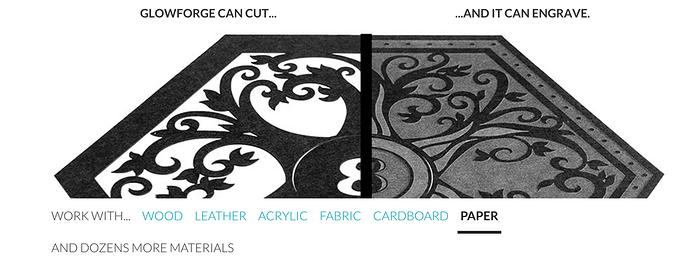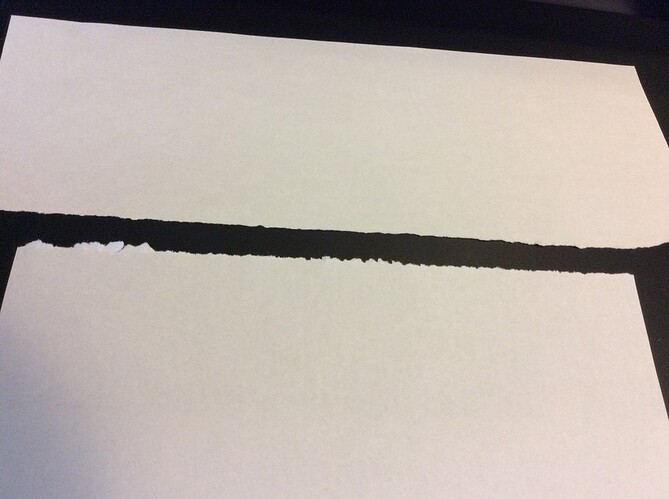Is it possible to score paper with the forge for folding later? Or would the laser just slice through too quickly?
Huh… I wrote up a response on the assumption that scoring was just pre-folding. Did a quick search and it looks like scoring can be pre-fold, but is more often shallow cuts.
A shallow cut is exactly what engraving is. Your settings to engrave paper without cutting it will be very precise, and completely depend on the paper you are using (manufacturer, dyes, stock…). But it is quite possible to find a setting which will engrave paper, so that should work as scoring.
Hmmm now that is interesting. Engraving paper. Just curious can one assume you could also cut paper (like a whole stack) and not discolor it?
Scoring paper should be possible but it might not be as beneficial as you imagine. It’s just a matter of finding the right power setting for the paper to cut halfway through but not all the way through.
I had a 40W laser for quite some time and did a fair amount of paper crafting with it. Scoring with a biro crushes the paper and makes it easier to fold along the line. Scoring with the laser actually cuts halfway through the paper, the paper easily folds along this line but it has a tendency to split and de-laminate. The top half of the paper tends to tear away from the bottom half.
I always found it far more effective to cut a dotted line and fold along that instead. You don’t have to worry about having the exact power settings because you’re either cutting all the way through or not at all.
You can cut multiple sheets of paper but you tend to discolour the lower sheets and burn the top sheets, because you have to increase the power to get through all the sheets. It’s best if you cut one sheet at a time unless you can live with the marks. http://msraynsford.blogspot.co.uk/2015/04/triple-cut-paper.html
Interesting, I had thought of the dotted line approach, but didn’t know if scoring would be better or not. Glad to see some practical experience here.
Yes. Thank you so much for sharing that. I currently use a plotter but was thinking I could get lazy and let the laser make really quick work of a small stack. I prefer the scored edges when folding but sometimes there isn’t time for that so the dotted approach does work relatively well. When all you have is a hammer, everything is a nail.
Yes. We do this all the time for papercraft masks. Even an 80W laser can be dialed down to just partially score the paper.
Much of that depends on the paper and any additives/binders in it. But a bit of smoke damage is not uncommon when cutting some materials. You would likely want to discard the top and bottom sheets if you cut a stack. One option would be to use cheaper paper on the top and bottom layers as a sacrificial material.
For example, when cutting leather I found it helps a lot to cover it with blue painters tape first, to protect the surface from smoke damage.
I really enjoy this forum.I’m learning so much!
I am also interested in this for the purposes of printing on paper via engraving, for example, not just cutting out a playing card, but engraving the image and text as well. Based on what I see here, as long as I get the settings correct, it should be possible.
@chadmart1076, you get the prize for resurrecting a classic thread on Throwback Thursday. I have been doing the same. So much stuff I forgot I knew! We can’t just rely on @rpegg to quote all the posts, although he is so good and patient👍🏽
There was some discussion of cutting stacks of paper in this thread, as well.
http://community.glowforge.com/t/wedding-invites/24?u=cmreeder
I also do dashed lines for scoring paper. I know this thread is older, but thought it worthwhile to mention that the type of dashed lines makes a big difference. A lot of close, small dashes will sort of work like perforated paper, and might have a tendency to tear. It looks pretty, though. This is also a good option is you need a fold line that will hinge both ways, if that makes sense. Once this is folded, it doesn’t necessarily hold the fold, and will move easily. If you want movement, that’s a good thing. If you want structure, maybe not so much. Widely spaced long dashes is very sturdy, but the paper can sort of pucker at the cuts. That’s not a good description, but I’ve found this doesn’t make for a very pretty fold. It is easy to fold, however, and pretty resilient. I think it would be good for something that needs to stand up to some abuse, though, like maybe a project for a child. Small and widely spaced dashes makes for a pretty fold, and is sturdy, but can sometimes be a bit harder to fold as the scored line isn’t as obvious; if you aren’t careful, you might not fold perfectly along this line. Closely spaced long dashes is weak and not very appealing. I mean, it’s practically a cut line. But if you wanted something to hold together until you neatly tear it with ease, this is a good option.
Bookmarked! That’s some great advice.
Thank you, @erin! That’s super helpful.
I have been messing around with cutting dashed lines and it seems that in one direction it tears much more readily that the other.
My wife, the paper nerd, tells me that paper has a distinct grain, and that it folds best when the fold goes with it. Maybe you can comment from experience?
Im not sure if it applies to all paper, like handmade paper or modern vellum, but the manufacturing process makes almost all the paper fibers lay in the same direction, so it ends up with a grain like wood. Or fabric? Paper obviously tears easily in all directions, but tears more neatly if you tear with the grain than against. I think some wood might be similar, where it splinters more when cut against the grain?
Here’s a photo of just cheap computer paper. I didn’t fold or score either piece ( just tore it over the edge of my desk to keep it straight). The top piece is torn with the grain and the bottom piece is against the grain.
With folding, I’m a little shakier on the specifics. I think you’re supposed to fold with the grain to get a stronger cleaner fold. If you fold against the grain, it’s supposedly weaker, and you will sometimes tear things up when you score it (by which I mean score it with a bone folder or your finger nail or something).
I’m sure there are practical applications for this with cutting dashed lines, but I’ve never really paid close enough attention to when folds tear - I think I just always assumed I’ve fiddled with them too much. If you want to run some experiments, 8.5 by 11 paper is usually long grain. If you fold the paper parallel to the long side, you’ll fold with the grain. If you fold it like a card, you’ll fold against the grain. The Internet is telling me that the last paper dimension notes the grain (so, on 12 x 9 paper it would be the short side, I guess), but I’m not sure I’d bet my life on that.
Grain in paper depends a lot on the type of paper and how it was made.
Yes, mass produced paper tends to have a preferred direction (and short fibers).
The opposite example is Tyvek (ok, not quite a paper but everyone has seen it) or Unryu (mulberry) papers with very long fibers – with both, tearing will always give a rough/deckled edge.
Short fiber handmade paper will tear roughly, but with a very different sort of edge and no preferred direction.
yep - just try tearing a newspaper coupon or article out. One direction it’s like cutting butter with a hot knife - the other direction like being extremely drunk and cutting butter with another stick of butter.

